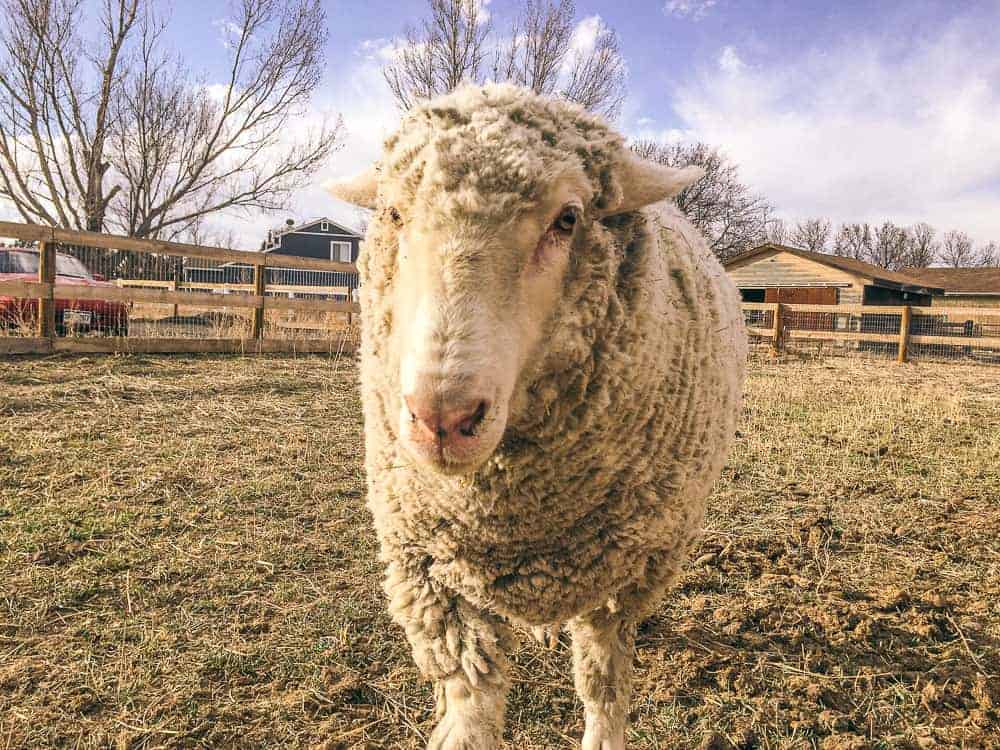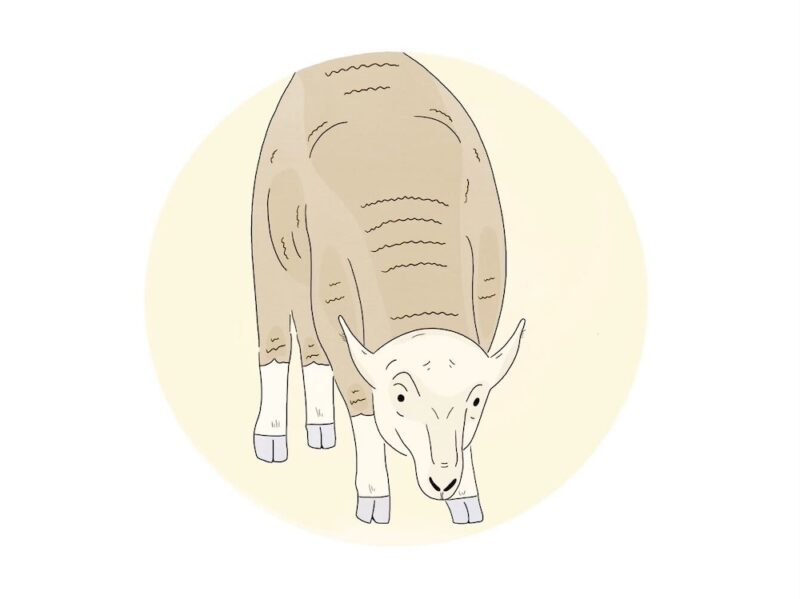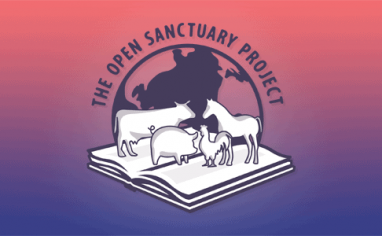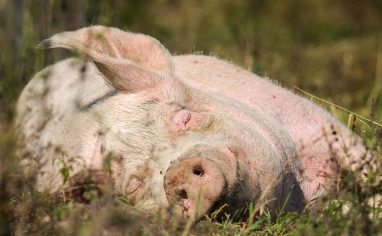
This resource was fully reviewed and updatedA member of The Open Sanctuary Project’s staff has given this resource a full review and provided updates where necessary. by a member of The Open Sanctuary Project. It was originally published on August 26, 2018.
Sheep can be affectionate, curious, and playful, but there are times when they may prefer to be left alone or when what is going on around them causes them to feel uneasy, fearful, or agitated. While some residents may always prefer to keep their distance, and new residents may be wary of you at first, even the most docile sheep resident who typically loves hanging out with you may need some space sometimes! To ensure your own safety and the safety and well-being of your residents, it’s critical to recognize when a resident is telling you they need space or do not like something you are doing. Failing to do so could cause unnecessary stress for residents, not to mention potentially putting you or other caregivers in a dangerous situation.
Ask An Expert
If you are not used to being around sheep and are bringing sheep residents into your sanctuary, you should have an expert give you hands-on training regarding how to safely be around sheep and how to recognize important vocal and physical cues.
Rams Require Additional Safety Considerations
All sanctuary sheep residents should be neutered when your veterinarian deems it safe to do so, but if a mature ram (a male sheep who has not been neutered) finds their way to your sanctuary, there may be a brief period of time before they are neutered when caregivers need to work around an intact male. It’s important to understand that rams have the potential to behave quite differently than females and neutered males (wethers). We encourage folks to gain quite a bit of experience with sheep before working with mature rams in order to prevent a potentially dangerous situation they are not prepared for.
Understanding How Sheep Respond To Perceived Threats
To work around sheep safely and thoughtfully, it’s important to understand how they respond to perceived threats. Sheep are prey animals. As such, they have certain capabilities and employ various strategies to protect themselves from predators. This includes an excellent sense of hearing, an extremely wide field of vision that can exceed 300 degrees, and flocking together with other sheep. While every sheep is an individual, in general, when sheep feel threatened, they will flee.
Startling one sheep can set off a swift chain reaction, causing the entire group to flee in unison. This can be quite dangerous depending on the size of the group and the setting. Not only could nearby humans be injured, but it could also be quite dangerous for the residents. Individuals could fall or be knocked over and be trampled by others, and if the entire group tries to rush through a doorway or gate, individuals could be crushed or otherwise injured in the process. If they cannot flee, sheep will stay close to each other, and some individuals may respond by charging (or showing threatening displays such as foot stomping).
Signs A Sheep Wants To Be Left Alone

It’s important to be able to recognize signs of fear and stress so that you can take steps to alleviate these feelings and also so you can avoid putting yourself in a potentially dangerous situation. A sheep who is stressed or scared is more likely to respond in a way that could cause injury to the humans around them, and therefore it’s important to either give the individual space to calm down or, if that is not possible, to take steps to protect yourself.
While the following signs are not a guarantee that a resident is about to respond in a way that could cause injury (such as panicking/fleeing or headbutting you), extra care should be taken when working around individuals exhibiting the following signs:
- Loudly vocalizing as you approach
- Shaking/full-body tremors (keep in mind that a resident will shiver if they are cold)
- Anxiously pacing back and forth
- Stomping or pawing at the ground (residents may also paw at the ground before lying down)
- Raising their head and tipping it toward you
- Approaching with ears pulled back or head down (as seen in the graphic above)
- Taking a few steps back while facing you (they may be about to headbutt you)
By recognizing these cues, you can take appropriate steps to diffuse the situation and/or to protect yourself. For example, if you see that your presence is causing a resident to exhibit signs of panic (shaking, pacing, and vocalizing), you could back up and give them more space or ensure they have a clear path to move away from you. NEVER turn your back to a ram exhibiting the signs above. Actually, it’s not a good idea to turn your back on a ram regardless of their demeanor –you don’t want to be caught off guard and slammed from behind.
Learn What Is Typical For Each Individual
As you get to know your residents, you will learn how they typically respond to different situations and to human presence (though they may respond differently to different humans). If you notice that a sheep resident is behaving differently than you would expect, this could be cause for concern and should be investigated. We recommend keeping a close eye on them and looking for other signs of concern or unhealthy social dynamics.
Understanding Things That Make A Sheep Uncomfortable
While our goal should be to avoid situations and activities that could make a resident uncomfortable as much as possible, there will inevitably be times when you simply can’t. However, understanding some of the things that could make a sheep resident uncomfortable can help you make more thoughtful choices about how you interact with them. Things that might make a sheep resident uncomfortable include:
Entering Their Flight Zone
Like most herd animals, sheep have a flight zone. This is the imaginary space around an individual that is essentially their personal space. Entering this space will make the individual feel uncomfortable or even threatened, depending on the circumstances. The size of an individual’s flight zone will vary based on things like their comfort level around humans, past experiences, and personality. It can also change in size depending on their surroundings, the situation, and how they are being approached. For example, sheep typically have a smaller flight zone when in a smaller, more enclosed space, and a larger flight zone when in wide open spaces. You can read more about the factors that affect the size of a sheep’s flight zone here.
Isolation
Sheep are highly social and, as mentioned above, naturally live in flocks, which provides various benefits, including protection from predators. Because they know being with the flock helps keep them safe, being separated from other sheep is likely going to cause them distress. To honor their social needs and promote well-being, we recommend avoiding situations where a sheep resident has to live alone, as this can lead to depression, boredom, and unease (resulting in a larger flight zone). However, there may be times when you need to temporarily single out or separate a sheep resident, and this must be done carefully and calmly. Be sure to limit their time separated from others and consider if they can be separated with one or two companions.
Loud Noises
Sheep are sensitive to loud noises. Being yelled at, hearing barking dogs, or encountering other loud noises can spook and agitate sheep. Likely, their flight zone will increase as a result, and they may feel they need to flee. Try to be very cautious with the volume around sheep and keep talkative dogs away from them to prevent incidents.
Interfering With Maternal Instincts
If you’re caring for a mother ewe with a nursing lamb, they may be rightfully protective of their young and will likely be very stressed if they cannot get to their baby. Be sure to provide them with a safe space and avoid separating them from one another unless absolutely necessary. Even after the baby has grown up a bit, you may find their mother continues to be protective and does not respond well to even temporary separations.
Negative Past Experiences
Sheep have a great memory. If they have a negative experience at your sanctuary (or were rescued from very poor or abusive conditions), they are likely going to keep that in mind whenever they face new experiences. If a sheep resident appears to be frightened or exhibits confrontationalBehaviors such as chasing, cornering, biting, kicking, problematic mounting, or otherwise engaging in consistent behavior that may cause mental or physical discomfort or injury to another individual, or using these behaviors to block an individual's access to resources such as food, water, shade, shelter, or other residents. behaviors around humans, this may be a result of their past experiences. Be sure to give these individuals plenty of patience and personal space. When you do have to approach them, do so thoughtfully, paying attention to how they respond to your presence and doing what you can to keep their stress levels down.
Dark Spaces And New Spaces Or Objects
Although sheep have generally good vision, they have a poor sense of depth perception and details. This can mean that they may be reluctant or nervous about entering areas where they cannot see well or interacting with something they haven’t seen before. If you must bring sheep to an area that they aren’t used to or one that is darker than usual, be extra gentle and give them time to explore if possible.
How To Enter And Move Around Sheep Living Spaces
With the above in mind, avoid frightening residents or making them feel threatened when entering and moving around their living spaceThe indoor or outdoor area where an animal resident lives, eats, and rests., and strive to do the following:
- Enter the space calmly and quietly. You don’t have to be silent, but avoid shouting or slamming gates, which could startle residents.
- Move at a relaxed pace whenever possible.
- Be mindful of where you are in relation to residents. Watch for signs that you have entered a resident’s pressure zone and avoid entering their flight zone. Remember that their flight zone may be bigger when in a large, wide-open space than in an enclosed space.
- Give extra space to residents who appear stressed or on high alert. As you get to know your residents, you’ll learn which residents appreciate extra space and which tend to be comfortable with you coming closer to them.
- Avoid cornering a resident or blocking their path (unless your goal is to approach or restrain them, in which case this must be done thoughtfully).
Be Mindful Of Where You Position Yourself
A frightened sheep (or group of sheep) will likely try to flee from a perceived threat. If you happen to be blocking the only path out of the area, they may attempt to run past you to escape. This can lead to a dangerous situation. If the doorway is small or if multiple sheep are trying to run past you, they could push you into a wall or knock you down. Some individuals may even try to jump over you if they are agile enough and think that is their best chance of escape. Caregivers have been injured by sheep attempting to jump over them.
Spend Time With Your Sheep Residents Just Hanging Out!
Caregivers often have a seemingly endless list of tasks that must be done daily. It’s understandable that folks may become hyper-focused on crossing things off their to-do list, hurrying from task to task to get everything done. But it’s important to consider that if you (or the caregiving team more generally) only enter resident spaces to complete tasks, leaving as soon as they are done, this does not leave much time to establish and nurture a relationship with your residents. Finding time to just be with your residents and allowing them to choose if and when to approach you and interact with you can go a long way and is a worthwhile use of your time. Not only can it help residents get comfortable with your presence, but it can also give you an opportunity to familiarize them with human touch if they come over and are receptive to it. It’s important to nurture consent-based interactions and to keep in mind that each individual will have their own preferences when it comes to touch, but you may find your residents sheep enjoy having their chest, back, or the top of their head scratched. Some individuals may even grow impatient if they feel you are spending too much time scratching someone else and will paw you to let you know it’s their turn!
The Importance Of Healthy Boundaries
While there are a variety of factors that contribute to how sheep respond to human presence, some of which are beyond our control, one thing you can do to help avoid potential issues in the future is to establish healthy boundaries with residents. While it tends to be more of an issue when human-raised calves and goat kids, there have been some instances of human-raised lambs interacting with their caregivers in dangerous ways, not out of aggression, but due to learned behavior. While play between human caregivers and lambs can be fun for everyone involved, be sure to consider what sort of message you are sending with how you play. Playfully using your hand or knee to “headbutt” with a lamb may seem harmless with small babies, but those lambs are going to grow into adult sheep, and if they continue to want to play in this way, you could have a potentially dangerous situation on your hands (or more likely, your knees!). Headbutting directed at humans, even when playful, can result in injury, so keep this in mind when playing with residents!
Tips For Safely Handling A Sheep
In an ideal world, residents would be comfortable enough with their caregivers and the types of care they receive that they willingly participate in them. While this should be a goal caregivers are constantly working toward, it’s also important to recognize that it’s a process, and you might not get there with everyone in every situation. In the meantime, we still need to be able to perform certain care-related tasks even if the individual is not fully on board. This may mean needing to calmly and gently restrain them. In other settings, restraint may focus primarily on human convenience, but in sanctuary spaces, the focus should be on resident comfort and well-being as well as on the safety of both the humans and the residents involved.
Performing certain care tasks while an individual is completely unrestrained could pose a safety risk to them or to the human(s) working with them. For example, when trimming a resident’s hooves, using sharp trimmers near an unrestrained individual, who could move at any time, could put both them and you at risk of being accidentally cut or stabbed. Similarly, a caregiverSomeone who provides daily care, specifically for animal residents at an animal sanctuary, shelter, or rescue. who is crouched down to trim a horned resident’s hooves could be accidentally injured should the resident simply turn their head.
That said, every individual is going to react to restraint differently. Some individuals may remain calmer with less restraint. This is one of the many reasons why it’s important to watch each individual’s reaction and make adjustments until you find something that works. If you are working with a resident who does best with minimal restraint, it can be a good idea to have a helper on hand for certain tasks, especially those that require you to use both your hands or to have your head within range of someone’s horns. This way, your helper can watch for potential safety issues and step in before anyone gets hurt (for example, watching that you don’t get hit in the head with the resident’s horns and stepping in to prevent this from happening if needed).
To learn about how to safely restrain a sheep using gentle methods, check out our resource here.
SOURCES:
Social Behavior Of Sheep | Merck Veterinary Manual
Sheep Behavior | Sheep 101 (Non-Compassionate Source)
An Introduction To Sheep Behavior | University Of Illinois (Non-Compassionate Source)
Sheep Senses | Lifestyle Block (Non-Compassionate Source)
Sheep And Goat Medicine, Second Edition | D.G. Pugh And A.N. Baird (Non-Compassionate Source)
Sheep Behavior | Sheep 201 (Non-Compassionate Source)
The Behaviour Of Sheep And Goats | C. Dwyer (Non-Compassionate Source)
Handling | Maryland Small Ruminant Page (Non-Compassionate Source)
Non-Compassionate Source?
If a source includes the (Non-Compassionate Source) tag, it means that we do not endorse that particular source’s views about animals, even if some of their insights are valuable from a care perspective. See a more detailed explanation here.








